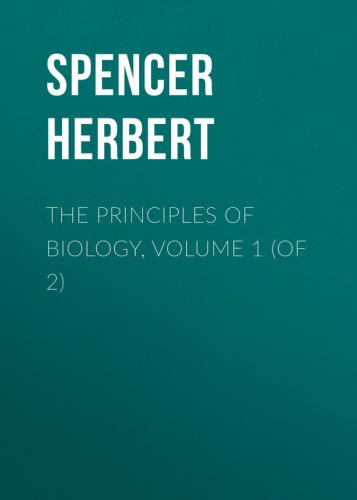8
To exclude confusion it may be well here to say that the word "atom" is, as before explained, used as the name for a unit of a substance at present undecomposed; while the word "molecule" is used as the name for a unit of a substance known to be compound.
9
On now returning to the subject after many years, I meet with some evidence recently assigned, in a paper read before the Royal Society by Mr. J. W. Pickering, D.Sc. (detailing results harmonizing with those obtained by Prof. Grimaux), showing clearly how important an agent in vital actions is this production of isomeric changes by slight changes of conditions. Certain artificially produced substances, simulating proteids in other of their characters and reactions, were found to simulate them in coagulability by trifling disturbances. "In the presence of a
10
After this long interval during which other subjects have occupied me, I now find that the current view is similar to the view above set forth, in so far that a small molecular disturbance is supposed suddenly to initiate a great one, producing a change compared to an explosion. But while, of two proposed interpretations, one is that the fuse is nitrogenous and the charge a carbo-hydrate, the other is that both are nitrogenous. The relative probabilities of these alternative views will be considered in a subsequent chapter.
11
When writing this passage I omitted to observe the verification yielded of the conclusion contained in § 15 concerning the part played in the vital processes by the nitrogenous compounds. For these vegeto-alkalies, minute quantities of which produce such great effects in exalting the functions (
But the evidence furnished a generation ago by these vegeto-alkalies has been greatly reinforced by far more striking evidence furnished by other nitrogenous compounds – the various explosives. These, at the same time that they produce by their sudden decompositions violent effects outside the organism, also produce violent effects inside it: a hundredth of a grain of nitro-glycerine being a sufficient dose. Investigations made by Dr. J. B. Bradbury, and described by him in the Bradshaw Lecture on "Some New Vaso-Dilators" (see
12
This interpretation is said to be disproved by the fact that the carbo-hydrate contained in muscle amounts to only about 1.5 of the total solids. I do not see how this statement is to be reconciled with the statement cited three pages back from Professor Michael Foster, that the deposits of glycogen contained in the liver and in the muscles may be compared to the deposits in a central bank and branch banks.
13
Before leaving the topic let me remark that the doctrine of metabolism is at present in its inchoate stage, and that the prevailing conclusions should be held tentatively. As showing this need an anomalous fact may be named. It was long held that gelatine is of small value as food, and though it is now recognized as valuable because serving the same purposes as fats and carbo-hydrates, it is still held to be valueless for structural purposes (save for some inactive tissue); and this estimate agrees with the fact that it is a relatively stable nitrogenous compound, and therefore unfit for those functions performed by unstable nitrogenous compounds in the muscular and other tissues. But if this is true, it seems a necessary implication that such substances as hair, wool, feathers, and all dermal growths chemically akin to gelatine, and even more stable, ought to be equally innutritive or more innutritive. In that case, however, what are we to say of the larva of the clothes-moth, which subsists exclusively on one or other of these substances, and out of it forms all those unstable nitrogenous compounds needful for carrying on its life and developing its tissues? Or again, how are we to understand the nutrition of the book-worm, which, in the time-stained leaves through which it burrows, finds no proteid save that contained in the dried-up size, which is a form of gelatine; or, once more, in what form is the requisite amount of nitrogenous substance obtained by the coleopterous larva which eats holes in wood a century old?
14
This chapter and the following two chapters originally appeared in Part III of the original edition of the
15
See
16
This paragraph replaces a sentence that, in
17
Speaking of "the general idea of
[When the original edition was published Dr. J. H. Bridges wrote to me saying that in the
18
In further elucidation
